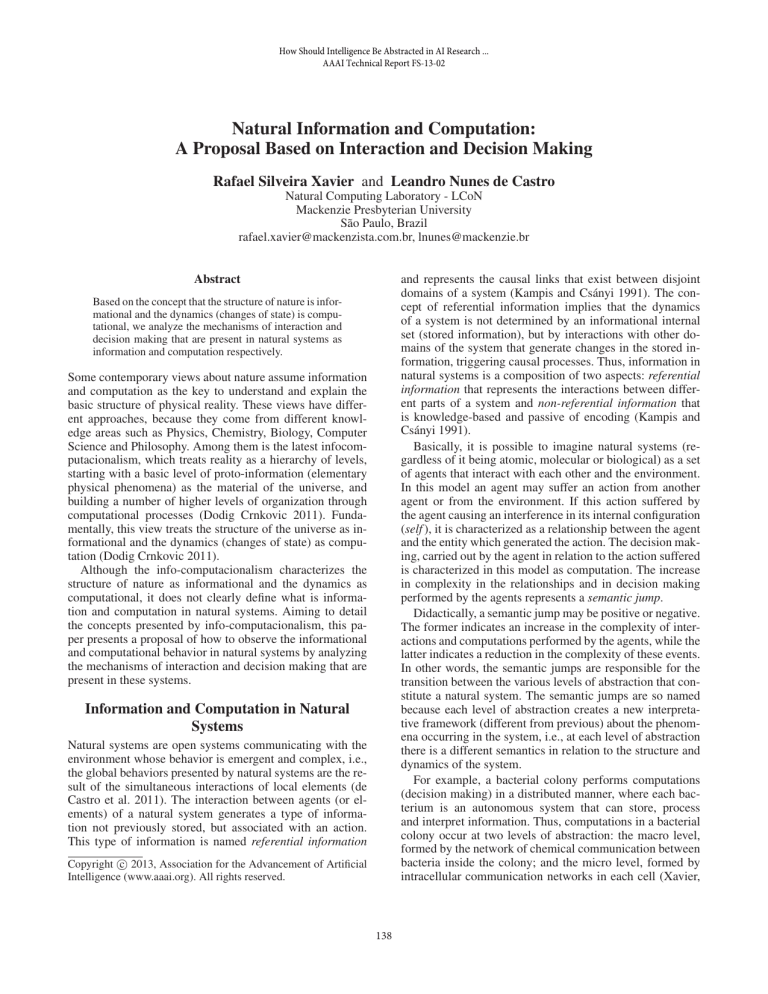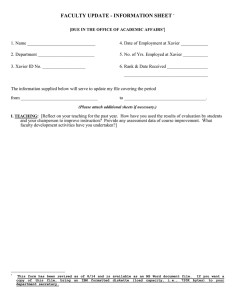
How Should Intelligence Be Abstracted in AI Research ...
AAAI Technical Report FS-13-02
Natural Information and Computation:
A Proposal Based on Interaction and Decision Making
Rafael Silveira Xavier and Leandro Nunes de Castro
Natural Computing Laboratory - LCoN
Mackenzie Presbyterian University
São Paulo, Brazil
rafael.xavier@mackenzista.com.br, lnunes@mackenzie.br
Abstract
and represents the causal links that exist between disjoint
domains of a system (Kampis and Csányi 1991). The concept of referential information implies that the dynamics
of a system is not determined by an informational internal
set (stored information), but by interactions with other domains of the system that generate changes in the stored information, triggering causal processes. Thus, information in
natural systems is a composition of two aspects: referential
information that represents the interactions between different parts of a system and non-referential information that
is knowledge-based and passive of encoding (Kampis and
Csányi 1991).
Basically, it is possible to imagine natural systems (regardless of it being atomic, molecular or biological) as a set
of agents that interact with each other and the environment.
In this model an agent may suffer an action from another
agent or from the environment. If this action suffered by
the agent causing an interference in its internal configuration
(self ), it is characterized as a relationship between the agent
and the entity which generated the action. The decision making, carried out by the agent in relation to the action suffered
is characterized in this model as computation. The increase
in complexity in the relationships and in decision making
performed by the agents represents a semantic jump.
Didactically, a semantic jump may be positive or negative.
The former indicates an increase in the complexity of interactions and computations performed by the agents, while the
latter indicates a reduction in the complexity of these events.
In other words, the semantic jumps are responsible for the
transition between the various levels of abstraction that constitute a natural system. The semantic jumps are so named
because each level of abstraction creates a new interpretative framework (different from previous) about the phenomena occurring in the system, i.e., at each level of abstraction
there is a different semantics in relation to the structure and
dynamics of the system.
For example, a bacterial colony performs computations
(decision making) in a distributed manner, where each bacterium is an autonomous system that can store, process
and interpret information. Thus, computations in a bacterial
colony occur at two levels of abstraction: the macro level,
formed by the network of chemical communication between
bacteria inside the colony; and the micro level, formed by
intracellular communication networks in each cell (Xavier,
Based on the concept that the structure of nature is informational and the dynamics (changes of state) is computational, we analyze the mechanisms of interaction and
decision making that are present in natural systems as
information and computation respectively.
Some contemporary views about nature assume information
and computation as the key to understand and explain the
basic structure of physical reality. These views have different approaches, because they come from different knowledge areas such as Physics, Chemistry, Biology, Computer
Science and Philosophy. Among them is the latest infocomputacionalism, which treats reality as a hierarchy of levels,
starting with a basic level of proto-information (elementary
physical phenomena) as the material of the universe, and
building a number of higher levels of organization through
computational processes (Dodig Crnkovic 2011). Fundamentally, this view treats the structure of the universe as informational and the dynamics (changes of state) as computation (Dodig Crnkovic 2011).
Although the info-computacionalism characterizes the
structure of nature as informational and the dynamics as
computational, it does not clearly define what is information and computation in natural systems. Aiming to detail
the concepts presented by info-computacionalism, this paper presents a proposal of how to observe the informational
and computational behavior in natural systems by analyzing
the mechanisms of interaction and decision making that are
present in these systems.
Information and Computation in Natural
Systems
Natural systems are open systems communicating with the
environment whose behavior is emergent and complex, i.e.,
the global behaviors presented by natural systems are the result of the simultaneous interactions of local elements (de
Castro et al. 2011). The interaction between agents (or elements) of a natural system generates a type of information not previously stored, but associated with an action.
This type of information is named referential information
Copyright c 2013, Association for the Advancement of Artificial
Intelligence (www.aaai.org). All rights reserved.
138
Omar, and de Castro 2011). Depending on the level of abstraction we are watching the meaning of each entity is different. At a more basic level each colony can be understood
as a system, at a higher level as an agent, and the each semantic jump will represent a new set of entities and phenomena that are implemented using the structures and dynamics
of the lower layers.
It is possible to realize that the information in nature, in
its most basic form, is denoted by causal links (interactions)
between its elements and that the natural computations are
represented by decision making performed by these entities
in relation to the stimuli received. The study of the mechanisms of interaction, decision making and transitions (semantic jumps) between levels of abstraction in natural systems, such as in bacterial systems and molecular ones, can
bring a new light into the understanding about nature and
computing, besides making possible the development of new
bio-inspired systems for complex problem solving.
Acknowledgments
The authors thank CAPES, Fapesp, CNPq and Mackpesquisa for the financial support.
References
de Castro, L. N.; Xavier, R. S.; Pasti, R.; Maia, R. D.; Szabo,
A.; and Ferrari, D. G. 2011. The grand challenges in natural computing research: The quest for a new science. International Journal of Natural Computing Research (IJNCR)
2(4):17–30.
Dodig Crnkovic, G. 2011. Dynamics of information as natural computation. Information 2(3):460–477.
Kampis, G., and Csányi, V. 1991. Life, self-reproduction
and information: Beyond the machine metaphor. Journal of
theoretical Biology 148(1):17–32.
Xavier, R.; Omar, N.; and de Castro, L. 2011. Bacterial
colony: Information processing and computational behavior.
In Nature and Biologically Inspired Computing (NaBIC),
2011 Third World Congress on, 439–443.
139



